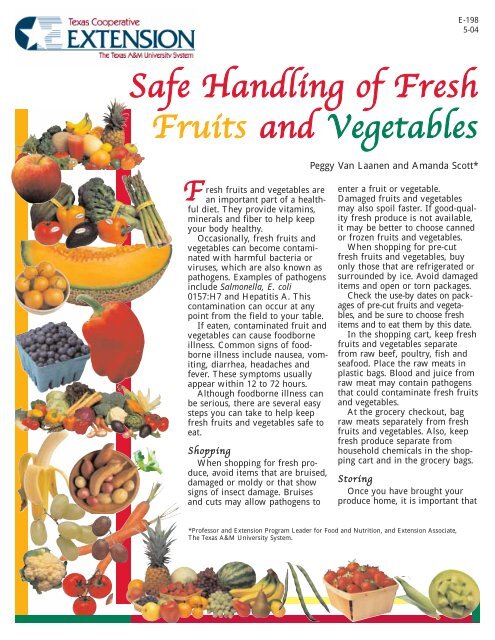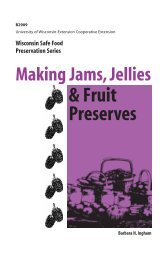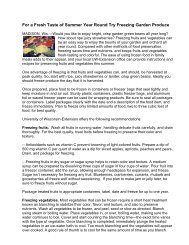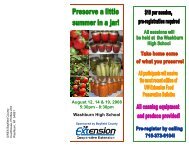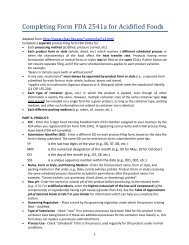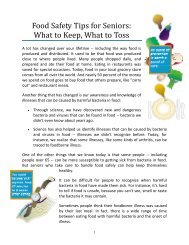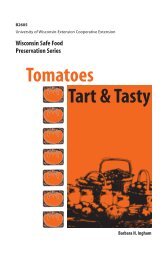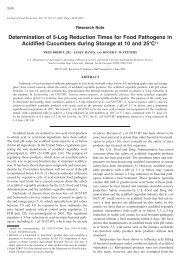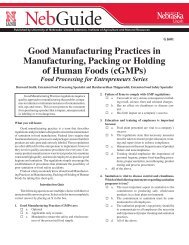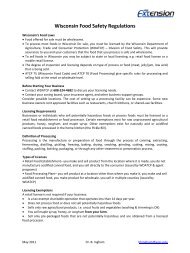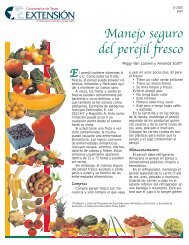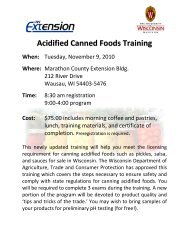Safe Handling of Fresh Fruits and Vegetables - UW Food Safety and ...
Safe Handling of Fresh Fruits and Vegetables - UW Food Safety and ...
Safe Handling of Fresh Fruits and Vegetables - UW Food Safety and ...
You also want an ePaper? Increase the reach of your titles
YUMPU automatically turns print PDFs into web optimized ePapers that Google loves.
esh fruits <strong>and</strong> vegetables are<br />
an important part <strong>of</strong> a healthful<br />
diet. They provide vitamins,<br />
minerals <strong>and</strong> fiber to help keep<br />
your body healthy.<br />
Occasionally, fresh fruits <strong>and</strong><br />
vegetables can become contaminated<br />
with harmful bacteria or<br />
viruses, which are also known as<br />
pathogens. Examples <strong>of</strong> pathogens<br />
include Salmonella, E. coli<br />
0157:H7 <strong>and</strong> Hepatitis A. This<br />
contamination can occur at any<br />
point from the field to your table.<br />
If eaten, contaminated fruit <strong>and</strong><br />
vegetables can cause foodborne<br />
illness. Common signs <strong>of</strong> foodborne<br />
illness include nausea, vomiting,<br />
diarrhea, headaches <strong>and</strong><br />
fever. These symptoms usually<br />
appear within 12 to 72 hours.<br />
Although foodborne illness can<br />
be serious, there are several easy<br />
steps you can take to help keep<br />
fresh fruits <strong>and</strong> vegetables safe to<br />
eat.<br />
Shopping<br />
When shopping for fresh produce,<br />
avoid items that are bruised,<br />
damaged or moldy or that show<br />
signs <strong>of</strong> insect damage. Bruises<br />
<strong>and</strong> cuts may allow pathogens to<br />
E-198<br />
5-04<br />
<strong>Safe</strong> <strong>H<strong>and</strong>ling</strong> <strong>of</strong> <strong>Fresh</strong><br />
<strong>Fruits</strong> <strong>and</strong> <strong>Vegetables</strong><br />
F<br />
Peggy Van Laanen <strong>and</strong> Am<strong>and</strong>a Scott*<br />
enter a fruit or vegetable.<br />
Damaged fruits <strong>and</strong> vegetables<br />
may also spoil faster. If good-quality<br />
fresh produce is not available,<br />
it may be better to choose canned<br />
or frozen fruits <strong>and</strong> vegetables.<br />
When shopping for pre-cut<br />
fresh fruits <strong>and</strong> vegetables, buy<br />
only those that are refrigerated or<br />
surrounded by ice. Avoid damaged<br />
items <strong>and</strong> open or torn packages.<br />
Check the use-by dates on packages<br />
<strong>of</strong> pre-cut fruits <strong>and</strong> vegetables,<br />
<strong>and</strong> be sure to choose fresh<br />
items <strong>and</strong> to eat them by this date.<br />
In the shopping cart, keep fresh<br />
fruits <strong>and</strong> vegetables separate<br />
from raw beef, poultry, fish <strong>and</strong><br />
seafood. Place the raw meats in<br />
plastic bags. Blood <strong>and</strong> juice from<br />
raw meat may contain pathogens<br />
that could contaminate fresh fruits<br />
<strong>and</strong> vegetables.<br />
At the grocery checkout, bag<br />
raw meats separately from fresh<br />
fruits <strong>and</strong> vegetables. Also, keep<br />
fresh produce separate from<br />
household chemicals in the shopping<br />
cart <strong>and</strong> in the grocery bags.<br />
Storing<br />
Once you have brought your<br />
produce home, it is important that<br />
*Pr<strong>of</strong>essor <strong>and</strong> Extension Program Leader for <strong>Food</strong> <strong>and</strong> Nutrition, <strong>and</strong> Extension Associate,<br />
The Texas A&M University System.
you store it properly at room temperature <strong>and</strong> in<br />
the refrigerator to prevent foodborne illness.<br />
At room temperature<br />
To store fruits <strong>and</strong> vegetables safely at room<br />
temperature:<br />
• Do not wash them before storage. Instead,<br />
wash them when you are ready to use<br />
them. If the produce is very dirty, rinse it<br />
<strong>and</strong> then dry it well before storing it.<br />
• Keep your storage areas clean <strong>and</strong> pest-free.<br />
Store fruits <strong>and</strong> vegetables in bowls, bins or<br />
mesh bags <strong>of</strong>f the floor.<br />
• Keep the produce in a cool, dry, dark place.<br />
Do not store it near heat sources such as<br />
ovens, water heaters, hot water pipes or<br />
direct sunlight. Heat causes food to spoil<br />
more quickly.<br />
• Store fresh fruits <strong>and</strong> vegetables away from<br />
household cleaning products. These products<br />
are poisonous.<br />
• Do not place heavy items on top <strong>of</strong> fruits<br />
<strong>and</strong> vegetables because bruising can cause<br />
spoilage.<br />
• Check stored fruits <strong>and</strong> vegetables <strong>of</strong>ten.<br />
Throw away items that show signs <strong>of</strong><br />
spoilage such as mold or slime.<br />
When in doubt about the safety <strong>of</strong> a fruit or<br />
vegetable, throw it out!<br />
In the refrigerator<br />
All fruits <strong>and</strong> vegetables must be stored in the<br />
refrigerator once they are cut or peeled. Pre-cut<br />
fruits <strong>and</strong> vegetables bought at the store should<br />
also be refrigerated immediately.<br />
Here are some tips on storing fruits <strong>and</strong> vegetables<br />
safely in the refrigerator:<br />
• Do not wash whole fruits <strong>and</strong> vegetables<br />
before storing them.<br />
• Be sure to store all fruits <strong>and</strong> vegetables in<br />
the crisper or produce drawer. Do not overload<br />
the crisper. It is best to buy only the<br />
amount <strong>of</strong> produce you will use within a<br />
few days.<br />
• Cover cut fruits <strong>and</strong> vegetables tightly with<br />
plastic wrap. Or, store them in sealed plastic<br />
bags or clean, air-tight containers.<br />
• Keep fruits <strong>and</strong> vegetables separate from<br />
raw beef, poultry, fish <strong>and</strong> seafood in the<br />
refrigerator. Place raw meats on the bottom<br />
shelf <strong>of</strong> the refrigerator in a tray or pan.<br />
This will prevent blood or juices from dripping<br />
onto fresh produce.<br />
• Do not place heavy items on top <strong>of</strong> fruits<br />
<strong>and</strong> vegetables.<br />
• Keep the temperature <strong>of</strong> your refrigerator at<br />
40 degrees F or below. Use a refrigerator<br />
thermometer to measure the temperature.<br />
• Clean the refrigerator as needed. Throw out<br />
spoiled food <strong>and</strong> wipe up spills with hot,<br />
soapy water.<br />
Preparing<br />
<strong>Food</strong> can also become contaminated when<br />
you are preparing it. To prevent foodborne illness,<br />
be sure to keep your h<strong>and</strong>s, your cooking<br />
area <strong>and</strong> utensils, <strong>and</strong> your produce clean.<br />
Wash your h<strong>and</strong>s with hot, soapy water for 20<br />
seconds before <strong>and</strong> after h<strong>and</strong>ling food <strong>and</strong> after<br />
touching raw meat, changing a diaper, using the<br />
restroom, h<strong>and</strong>ling a pet or touching anything<br />
that could contaminate your h<strong>and</strong>s. Dry your<br />
h<strong>and</strong>s with a paper towel.<br />
Also wash all utensils, countertops <strong>and</strong> cutting<br />
boards with hot, soapy water. Then sanitize<br />
them with a mixture <strong>of</strong> 1 teaspoon chlorine<br />
bleach in 1 quart <strong>of</strong> water. Do this before <strong>and</strong><br />
after preparing food. It is especially important to<br />
wash <strong>and</strong> sanitize cutting boards <strong>and</strong> utensils<br />
that have been in contact with raw meat before<br />
using them with fresh produce.<br />
Wash all whole fruits <strong>and</strong> vegetables before<br />
preparing them – even if the skin or rind will<br />
not be eaten. This prevents pathogens from<br />
being transferred from the rind or skin to the<br />
inside <strong>of</strong> the fruit or vegetable when it is cut.<br />
Wash fruits <strong>and</strong> vegetables in clean, running<br />
water. Do not use detergents, soaps or bleach to<br />
wash produce. These may change the taste <strong>and</strong><br />
could be poisonous.<br />
If the fruits <strong>and</strong> vegetables are firm (such as<br />
potatoes or melons), scrub them with a clean,<br />
sanitized fruit/vegetable brush. For s<strong>of</strong>t fruits<br />
<strong>and</strong> vegetables (such as tomatoes), gently rub<br />
them with your h<strong>and</strong>s to loosen the dirt.<br />
Remove <strong>and</strong> throw away the outer leaves <strong>of</strong> lettuce<br />
<strong>and</strong> cabbage before washing them.<br />
To wash berries, parsley <strong>and</strong> greens, put them<br />
in a clean col<strong>and</strong>er <strong>and</strong> spray them with a<br />
kitchen sink sprayer. Or, gently turn the produce<br />
as you hold it under running water. Be sure to<br />
turn <strong>and</strong> gently shake the col<strong>and</strong>er as you wash<br />
the produce.<br />
When chopping, slicing or peeling fresh produce,<br />
use separate cutting boards <strong>and</strong> utensils<br />
for raw meats <strong>and</strong> fresh produce, or wash <strong>and</strong><br />
sanitize them between foods.<br />
Once cut or peeled, fresh produce should be<br />
refrigerated within 2 hours. If it is left at room<br />
temperature for more than 2 hours, throw it<br />
away.<br />
Remember: To prevent foodborne illness, buy<br />
good-quality fruits <strong>and</strong> vegetables, store them<br />
properly <strong>and</strong> wash them thoroughly.
Tri-State Fruit <strong>and</strong> Vegetable <strong>Safe</strong>ty Consortium<br />
http://fruit<strong>and</strong>vegetablesafety.tamu.edu<br />
This publication was sponsored by a grant from the Initiative<br />
for Future Agriculture <strong>Food</strong> Systems, a program <strong>of</strong> the<br />
Cooperative State Research, Education, <strong>and</strong> Extension Service,<br />
which is an agency <strong>of</strong> the United States Department <strong>of</strong><br />
Agriculture (USDA-CSREES-IFAFS Grant # 00-52102-9637).<br />
Produced by Agricultural Communications,<br />
The Texas A&M University System<br />
Extension publications can be found on the Web at:<br />
http://tcebookstore.org<br />
Visit Texas Cooperative Extension at:<br />
http://texasextension.tamu.edu<br />
Educational programs <strong>of</strong> Texas Cooperative Extension are open to all people without regard to race, color, sex, disability, religion, age or<br />
national origin.<br />
Issued in furtherance <strong>of</strong> Cooperative Extension Work in Agriculture <strong>and</strong> Home Economics, Acts <strong>of</strong> Congress <strong>of</strong> May 8, 1914, as amended,<br />
<strong>and</strong> June 30, 1914, in cooperation with the United States Department <strong>of</strong> Agriculture. Chester P. Fehlis, Director, Texas Cooperative<br />
Extension, The Texas A&M University System.<br />
New


